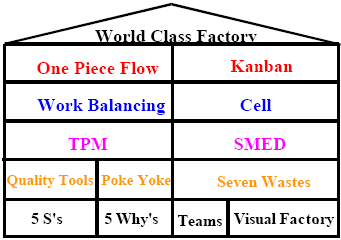5-S's
- S1-Sort: Separate out all things unnecessary and eliminate.
- S2-Set in Order (Straighten): Arrange all things for easy access.
- S3-Shine (Scrub): Clean work area and machines.
- S4-Standardize (Stabilize): Make cleaning and straightening a routine.
- S5-Sustain: Maintain the whole process
5 Why's
When a problem is found, ask "Why?" five times to get to the real root of the problem, instead of just the symptoms.
Teams
Continuous improvement depends on on-going diagnosis of problems, brainstorming countermeasures, and timely implementation. An empowered team approach is essential both within the normal operating group and in kaizen blitz events. The group’s collective intelligence is often greater than any outside expert’s opinion or a manager’s plans. (Adams,1999).
Visual Factory
Visual factory is a shop floor concept for making basic task and process information available and understandable at a glance for each operator. The elements of the visual factory are visual documentation of processes, visual production controls, visual quality controls, and visual process indicators (Grief, 1991).
Quality Tools
Lean manufacturing begins with process understanding and leads to process improvements. Typical quality tools are flow charts, frequency histograms, pareto diagrams, cause and effect diagrams, and control charts.
Poka Yoke
Poka Yoke are simple, low cost devices that prevent defective parts from being made or passed into the process. Poka Yoke eliminates defects by eliminating mistakes. Some typical Poka Yoke devices are different size guide pins, error detection and alarms, limit switches, counters and checklists (Shingo, 1986).
Seven Wastes
Waste is anything other than the absolute minimum resources of material, machines, and labor required to add value as defined by the customer. Waste is anything that the customer will not pay for or does not need. The seven wastes of manufacturing are (Ohno, 1988):
• Overproduction -- producing more than needed
• Waiting -- operator or machine idle time because the process is unbalanced
• Transportation -- any movement of material that does not directly support value added operations
• Processing -- any operation that does not add value to a product
• Inventory -- any inventory in excess of that required to produce product
• Motion -- any movement of people or machines which does not add value
• Defects -- all repairs to product to fulfill customer requirements
TPM
Total Productive Maintenance extends the practice of preventive maintenance with
the concepts of total quality control and total employee involvement. TPM is a company-wide
equipment maintenance program that covers the entire equipment life cycle and requires
participation by every employee. A key element of TPM is autonomous maintenance where the
operators are responsible for maintaining their own equipment (Nakajima 1988).
SMED
Single Minute Exchange of Dies is a system that allows the mixing of production as much as required without slowing output or creating higher costs associated with the waste of setup. Changeovers add no value and should be minimized. (Shingo, 1983)
Work Balancing
Work balancing maximizes operator efficiency by matching work content to TAKT time. “TAKT” is a German word for pace. TAKT time is the rate at which customers require the product. TAKT time defines the manufacturing line speed and the cycle times for all manufacturing operations.
TAKT time is computed as: |
Available work time per day |
Daily required customer demand in parts per day |
Cell
The proper placement of machines is essential in achieving an operational objective. Benefits of good cell layout are reduced inventory, a balanced cell, less walking time and an improved work area.
One Piece Flow
One-piece-flow is based on the concept of minimizing work-in-process by having operators throughout the process focus on making only one part at a time before starting the next part. That is, make-one, move-one. One-piece-flow dramatically reduces handling and transportation and provides immediate feedback to any overlooked defect (Sekine, 1992).
Kanban
The translation of kanban is card. A kanban system is an information system that controls (pulls) the production of the required parts in the required quantities and at the required time (Mondon, 1983).
Reference: Transferring Lean Manufacturing to Small Manufacturers: The Role of NIST-MEP (Spann, 1999)


